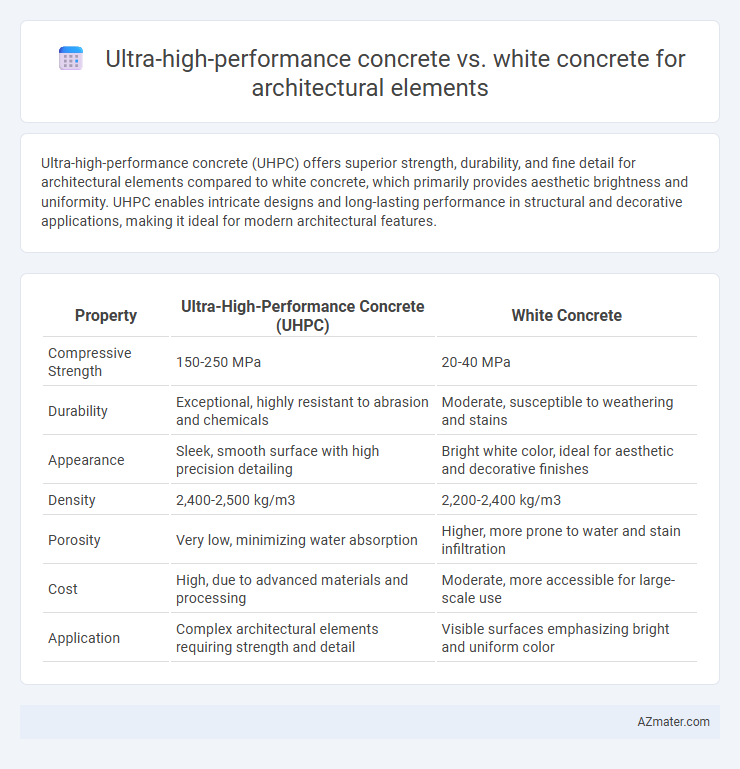Ultra-high-performance concrete (UHPC) offers superior strength, durability, and fine detail for architectural elements compared to white concrete, which primarily provides aesthetic brightness and uniformity. UHPC enables intricate designs and long-lasting performance in structural and decorative applications, making it ideal for modern architectural features.
Table of Comparison
| Property | Ultra-High-Performance Concrete (UHPC) | White Concrete |
|---|---|---|
| Compressive Strength | 150-250 MPa | 20-40 MPa |
| Durability | Exceptional, highly resistant to abrasion and chemicals | Moderate, susceptible to weathering and stains |
| Appearance | Sleek, smooth surface with high precision detailing | Bright white color, ideal for aesthetic and decorative finishes |
| Density | 2,400-2,500 kg/m3 | 2,200-2,400 kg/m3 |
| Porosity | Very low, minimizing water absorption | Higher, more prone to water and stain infiltration |
| Cost | High, due to advanced materials and processing | Moderate, more accessible for large-scale use |
| Application | Complex architectural elements requiring strength and detail | Visible surfaces emphasizing bright and uniform color |
Introduction to Ultra-High-Performance Concrete and White Concrete
Ultra-high-performance concrete (UHPC) is an advanced composite material characterized by superior strength, durability, and enhanced aesthetic qualities, often used in architectural elements requiring slim profiles and intricate detailing. White concrete, formulated with white cement and select aggregates, offers a bright, uniform color ideal for visually striking architectural applications and can be combined with pigments to achieve various shades. Both materials provide distinct benefits, with UHPC excelling in structural performance and resilience, while white concrete prioritizes aesthetic versatility and light-reflective properties in design.
Key Material Properties Comparison
Ultra-high-performance concrete (UHPC) exhibits superior compressive strength exceeding 150 MPa and enhanced durability with low permeability, outperforming white concrete, which typically has compressive strength around 30-50 MPa. UHPC offers exceptional tensile strength and flexural performance due to fiber reinforcement, enabling thinner and more complex architectural elements compared to the more brittle white concrete. The superior abrasion resistance and reduced shrinkage of UHPC result in longer-lasting architectural surfaces with minimal maintenance needs.
Durability and Longevity of Architectural Elements
Ultra-high-performance concrete (UHPC) offers superior durability and longevity for architectural elements due to its dense microstructure, high compressive strength exceeding 150 MPa, and exceptional resistance to environmental degradation, including freeze-thaw cycles and chemical attacks. White concrete, while aesthetically appealing with its bright color and smooth finish, generally has lower mechanical strength and porosity levels, making it more susceptible to cracking and surface wear over time. The enhanced durability and minimal maintenance requirements of UHPC make it a preferred choice for long-lasting architectural applications subjected to harsh conditions.
Aesthetic Qualities: Color, Texture, and Finish
Ultra-high-performance concrete (UHPC) offers superior aesthetic qualities with a consistently smooth texture and deep, rich color saturation, ensuring durability without compromising visual appeal. White concrete provides a bright, clean slate ideal for crisp architectural elements, allowing for a variety of finishes from matte to polished that enhance its reflective qualities. The choice between UHPC and white concrete depends on the desired finish longevity, color intensity, and the tactile experience suited to the architectural design.
Structural Performance and Load-Bearing Capacity
Ultra-high-performance concrete (UHPC) exhibits superior structural performance and load-bearing capacity compared to white concrete due to its dense microstructure and high compressive strength exceeding 150 MPa. White concrete, while visually appealing and suitable for aesthetic architectural elements, typically has lower compressive strengths ranging from 20 to 40 MPa, limiting its use in high-load applications. The enhanced durability and toughness of UHPC make it ideal for structural elements requiring exceptional load resistance and longevity in architectural designs.
Workability and Formability in Complex Designs
Ultra-high-performance concrete (UHPC) offers superior workability and formability compared to white concrete, allowing for intricate architectural elements with thin profiles and sharp edges. Its enhanced fluidity and fine particle size enable precise molding in complex designs without compromising strength. White concrete, while aesthetically valuable, often requires additives or careful mix adjustments to achieve similar workability and may be less adaptable to highly detailed forms.
Environmental Impact and Sustainability Factors
Ultra-high-performance concrete (UHPC) offers superior durability and lifespan, reducing the need for frequent repairs and lowering overall resource consumption compared to white concrete. UHPC's dense microstructure minimizes permeability, limiting environmental degradation and enhancing sustainability by reducing carbon footprint over the structure's lifecycle. White concrete, while aesthetically versatile for architectural elements, often requires higher cement content and maintenance, contributing to increased CO2 emissions and resource use.
Cost Implications and Project Budgeting
Ultra-high-performance concrete (UHPC) offers superior durability and design flexibility compared to white concrete but comes with significantly higher material and labor costs, impacting initial project budgets. White concrete provides a cost-effective alternative with aesthetic appeal suitable for large-scale architectural elements, helping maintain budget constraints. Careful evaluation of long-term maintenance expenses and project scale is essential when choosing between UHPC and white concrete for optimized cost planning.
Popular Architectural Applications and Case Studies
Ultra-high-performance concrete (UHPC) offers unparalleled strength and durability, making it ideal for complex architectural elements such as thin facades, cantilevered structures, and sculptural forms, demonstrated in iconic projects like the Pearl River Tower in China. White concrete, prized for its aesthetic appeal and reflective qualities, is widely used in modernist and minimalist designs, showcased in landmarks like the Getty Center in Los Angeles, where its clean, bright appearance enhances visual impact. Both materials enable innovative architectural expressions, but UHPC's superior mechanical properties support structural performance in high-stress applications, while white concrete excels in delivering striking, light-reflective surfaces for ornamental and facade elements.
Choosing the Right Concrete for Distinct Design Objectives
Ultra-high-performance concrete (UHPC) offers superior strength, durability, and flexibility, making it ideal for intricate architectural elements requiring thin profiles and enhanced structural performance. White concrete provides a clean, bright aesthetic with excellent color consistency, perfect for designs prioritizing visual appeal and light-reflective qualities. Selecting the right concrete depends on balancing UHPC's mechanical advantages with white concrete's aesthetic benefits to meet distinct design objectives.

Infographic: Ultra-high-performance concrete vs White concrete for Architectural element
 azmater.com
azmater.com